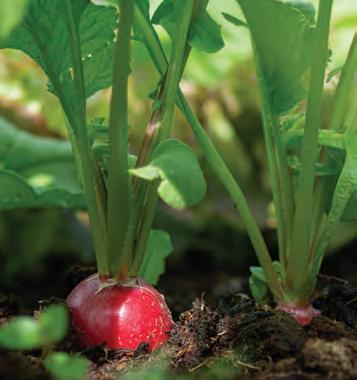
35 minute read
More Power
from 2021-03-MAR
National Renewables Leader Joins NCEMC
Amadou Fall has been named COO of the generation and transmission co-op
North Carolina’s Electric Cooperatives has named Amadou Fall as chief operating officer (COO) of the North Carolina Electric Membership Corporation (NCEMC). Fall will help lead and execute the cooperatives’ vision of building a brighter future for co-op members and communities through energy innovation and the provision of reliable, affordable and sustainable electricity and services.
“Amadou has a long track record of success in our industry, and we’re fortunate to be gaining his knowledge and expertise in diverse energy portfolio management, risk management, transmission modelling and congestion analysis, and renewable energy, particularly as we work to enhance grid management and achieve the carbon-reduction goals set forth in our ‘Brighter Future’ vision,” said Joe Brannan, executive vice president and chief executive officer (CEO) of North Carolina’s Electric Cooperatives. “He has worked with electric cooperatives throughout the nation, and his breadth of market and industry experience will put us in a position of strength as we continue to navigate a changing environment and engage with the people and communities we serve.”
Fall joined North Carolina’s Electric Cooperatives in mid-February after serving as CEO of the National Renewables Cooperative Organization (NRCO) since 2008. Based in Indiana, NRCO was formed by electric cooperatives across the country to facilitate the development and deployment of renewable energy resources.
Fall will succeed Mike Burnette, NCEMC’s outgoing senior vice president and COO, who is set to retire in mid-2021 after a 33-year career serving North Carolina’s electric cooperatives and their consumer-members and communities (see “Co-op Leader Named ‘Cleantech Champion of the Year’,” January 2021, page 8).
“I look forward to ensuring that North Carolina’s electric cooperatives remain an industry leader as they continue to deliver reliable, affordable and sustainable power and pursue innovative solutions for their members,” Fall said.
Throughout his career, Fall has served as an innovator who has initiated and developed key solutions and products in an evolving electric industry. He has held various roles at cooperatives, investor-owned utilities and diversified energy companies.
Prior to taking on the role of NRCO’s first CEO, Fall was an officer at ACES Power, managing regulatory, scheduling and transmission services for the portfolios of ACES members and customers. He holds a Bachelor of Science in electrical engineering from the New York Institute of Technology and a Master of Science in engineering management from Drexel University.
What is NCEMC?
The North Carolina Electric Membership Corporation is one of the largest generation and transmission electric cooperatives in the nation, providing reliable, affordable electricity to 25 member cooperatives in North Carolina. NCEMC owns power generation assets, purchases electricity through contracts, identifies innovative energy projects and coordinates transmission resources for its members. It is a part of the family of organizations, collectively known as North Carolina’s Electric Cooperatives, that supports the state’s 26 electric co-ops.



“Price is what you pay; value is what you get. Whether we’re talking about socks or stocks, I like buying quality merchandise when it is marked down.”
— wisdom from the most successful investor of all time
We’re going to let you in on a secret. Billionaires have billions because they know value is not increased by an in ated price. ey avoid big name markups, and aren’t swayed by ashy advertising. When you look on their wrist you’ll nd a classic timepiece, not a cry for attention–– because they know true value comes from keeping more money in their pocket. We agree with this thinking wholeheartedly. And, so do our two-and-a-half million clients. It’s time you got in on the secret too. e Jet-Setter Chronograph can go up against the best chronographs in the market, deliver more accuracy and style than the “luxury” brands, and all for far, far less. $1,150 is what the Jet-Setter Chronograph would cost you with nothing more than a di erent name on the face. With over two million timepieces sold (and counting), we know a thing or two about creating watches people love. e Jet-Setter Chronograph gives you what you need to master time and keeps the super uous stu out of the equation. A classic in the looks department and a stainless steel power tool of construction, this is all the watch you need. And, then some.
Your satisfaction is 100% guaranteed.
Experience the Jet-Setter Chronograph for 30 days. If you’re not convinced you got excellence for less, send it back for a refund of the item price. Time is running out. Now CLIENTS LOVE that the secret’s out, we STAUER WATCHES… can’t guarantee this $29 chronograph will stick around long. Don’t overpay to be underwhelmed. Put a precision êêêêê “The quality of their watches is equal to many chronograph on your wrist for that can go for ten times just $29 and laugh all the way the price or more.” to the bank. Call today! — Jeff from McKinney, TX
TAKE 90% OFF INSTANTLY!

When you use your OFFER CODE
Jet-Setter Chronograph $299†
Offer Code Price $29 + S&P Save $270
Absolute best price Absolute best price for a fully-loaded for a fully-loaded chronograph chronograph with precision with precision accuracy... accuracy... ONLY ONLY $29! $29!
Limited to the first 1900 responders to this ad only.
1-800-333-2045
Your Offer Code: JCW378-01
Rating of A+ Please use this code when you order to receive your discount.
“See a man with a functional chronograph watch on his wrist, and it communicates a spirit of precision.” — AskMen.com®
Stauer…Afford the Extraordinary. ®
• Precision crystal movement • Stainless steel case back & bracelet with deployment buckle • 24 hour military time • Chronograph minute & small second subdials; seconds hand • Water resistant to 3 ATM • Fits wrists 7" to 9"
‘Keeping the Lights On’ License Plate Donations Top $25,000
The new “Keeping the Lights On” specialty license plate honors the efforts of North Carolina’s utility lineworkers and was made available to North Carolina drivers last spring. The cost of the new plate is $30, with $20 from each plate benefiting the North Carolina Jaycee Burn Center at UNC Heath Care.
As of December 31, there are 1,275 active Keeping the Lights On plates, which amounts to $25,500 in donations to the Burn Center each year. Electric co-op members and employees make up a large part of this contribution.
“North Carolina’s electric cooperatives have a long-standing partnership with the Burn Center, which is recognized as one of the best comprehensive burn centers in the world,” said Dale Lambert, CEO of Randolph Electric Membership Corporation and member of the Burn Center’s advisory board. “The funds generated annually from the Keeping the Lights On license plates create a significant new component of our partnership, and will help ensure that the Burn Center can continue making strides in advancing scientific knowledge on burn care, rehabilitation and research. We thank all who have contributed through this effort so far.”
To apply for the new plate, complete the license plate application available at bit.ly/lightson-plate. If you are within 90 days of updating your vehicle registration, the plate will be sent once your new registration is processed.
The specialty license plates are available to all motor vehicles registered in North Carolina, except for vehicles for-hire, commercial plates over 26,000 lbs., farm tags, taxis, state-owned vehicles or vehicles with orange and black plates.
The cost of the new plate is $30, with $20 from each plate benefiting the North Carolina Jaycee Burn Center.
Bright Ideas Grants Help Support COVID-19 Response

North Carolina’s electric cooperatives have awarded more than $660,000 for 563 NC Bright Ideas education grants that will bring learning to life for more than 137,000 students across the state this school year.
Since 1994, electric cooperatives in North Carolina have partnered with educators statewide to provide Bright Ideas grants to K–12 educators for projects that engage students in innovative ways and wouldn’t otherwise be funded. Grants awarded over the years now total $13.6 million.
This year, in response to the COVID-19 pandemic, local cooperatives also provided support for projects that would help students adapt to a modified school environment.
“This year’s grant applications were filled with unique ideas geared to help students learn both in the classroom and virtually,” said Melissa Glenn, communications specialist at Newport based Carteret-Craven Electric Cooperative. “The innovative and creative learning initiatives developed by our area’s teachers are impressive, and we are proud to help them facilitate these projects.”
Pee Dee Electric grant winner Whitney Smith and her students at Washington Street Elementary

$13.6 MILLION
IN BRIGHT IDEAS GRANTS TO NORTH CAROLINA TEACHERS
13 2.7
THOUSAND
projects sponsored
MILLION
students inspired
The Fun of Food Gardening

Find your green thumb for the freshest produce around

By Pamela A. Keene
Grocery store produce never fresh enough? Whether you have acres of land or a sunny patio, you can grow your own vegetables. With a little bit of know-how, enjoying the bounty of your own labors can be fun, rewarding and tasty.
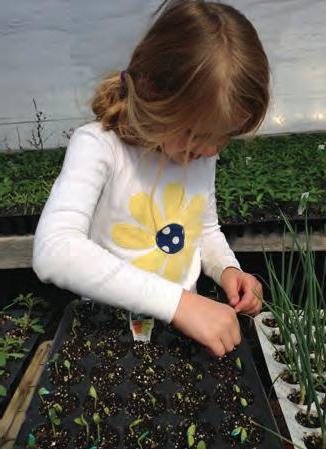

“There are so many reasons to grow your own vegetables, and the flavors are ever so much better than storebought,” says Joe Lamp’l, founder of joegardener.com and host of the “Growing a Greener World,” a nationally syndicated public television show. “Money can’t buy the kind of taste you get fresh from the garden or the satisfaction of knowing you’re eating what you’ve grown.”
Sunlight, soil and water Three components are vital to successful vegetable gardening: sunlight, soil and water.
“Choose your spot carefully to have plenty of sunlight, at least 6 hours a day,” Joe says. “Look for a place that’s not obstructed by trees or other buildings. Sunlight is one of the three basic components to successful gardening. The other two are good soil and having access to a reliable water source.”
Many gardeners build raised beds. By elevating the growing area off the ground, it’s easier to plant, tend and harvest with less bending or squatting.
“Most people choose wood to construct raised beds, but be sure to consider the size,” Joe says. “Use 2- by 12-inch boards to build a bed that your space can accommodate. Be sure to make it about 3 feet wide to give
Free help from the pros
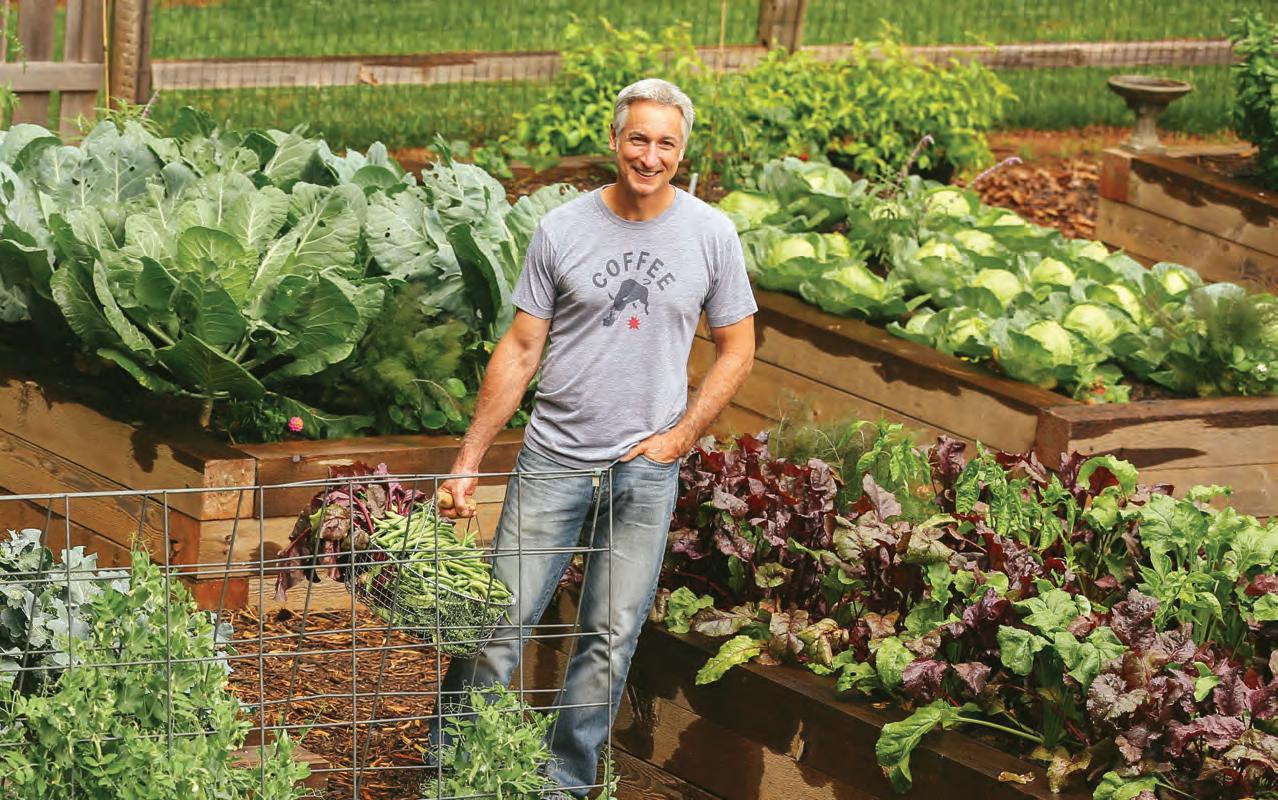
Joe Lamp’l recommends contacting NC Cooperative Extension (ces.ncsu.edu), which has offices in every county, for more gardening tips. “They can help solve pest and disease issues, answer your gardening questions and connect you with other gardeners,” he says. “And best of all, it’s free.” Joe Lamp’l, founder of joegardener.com, recommends raised beds for easy weeding, harvesting and for better soil quality control.



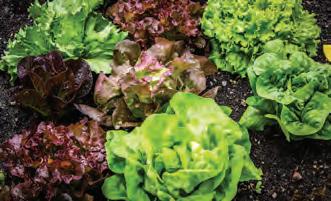
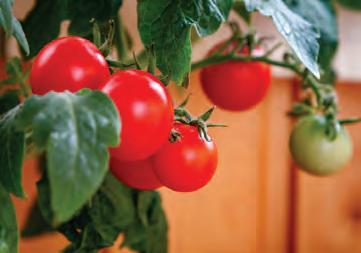
good access from all sides. This will make weeding and harvesting easier and you can more closely inspect your plants for signs of disease or insects as they grow.”
Leave enough space between beds for a wheelbarrow to pass to bring soil and mulch into the garden area.
The soil in your garden is crucial for good production, and with raised beds you have more control over the composition of the soil, the nutrients and the quality.
“Packaged garden soil is a good choice because it’s disease and weed free, but be mindful of the quality. Cheaper is not better,” Joe says. “The soil provides the main support for your plants, so it needs to have the right nutrients and the right texture. If the soil compacts too easily, it will be difficult for plant roots to thrive. Amend it with organic matter, also available at your box retailer or local nursery, to promote good growth.”
Make sure a good water source is nearby to avoid constantly moving hoses back and forth throughout the growing season. “In an ideal world, drip irrigation is best, but it can be costly to install into each bed,” he says. “Consider hand watering if you have a smaller garden plot. Apply the water directly to the base of the plant to prevent wetting the foliage. Prolonged periods of wet foliage can increase the potential for plant disease.”
Watering can be tricky. “Don’t water just because it’s a certain day of the week—you run the risk of overwatering,” he says. “Check the moisture level of the soil, and water accordingly, allowing enough flow to soak the ground. Then wait until the top inch or so of the soil feels dry before watering again. Your plants will be healthier and produce better results.”

Seeds or seedlings? Summer vegetables, such as tomatoes, eggplant and peppers, are generally easier to grow from seedlings, which can be purchased at a local nursery or box retailer. Look for healthy plants with several sets of leaves. They can be planted in the garden after the date of the last frost in your area.
“If you want to start from seeds, back up your indoor starting time to have nice-sized seedlings by the ideal planting time for your region,” Joe says. “I’m a big proponent of starting vegetable seeds indoors about six to eight weeks before planting, but continued on page 14

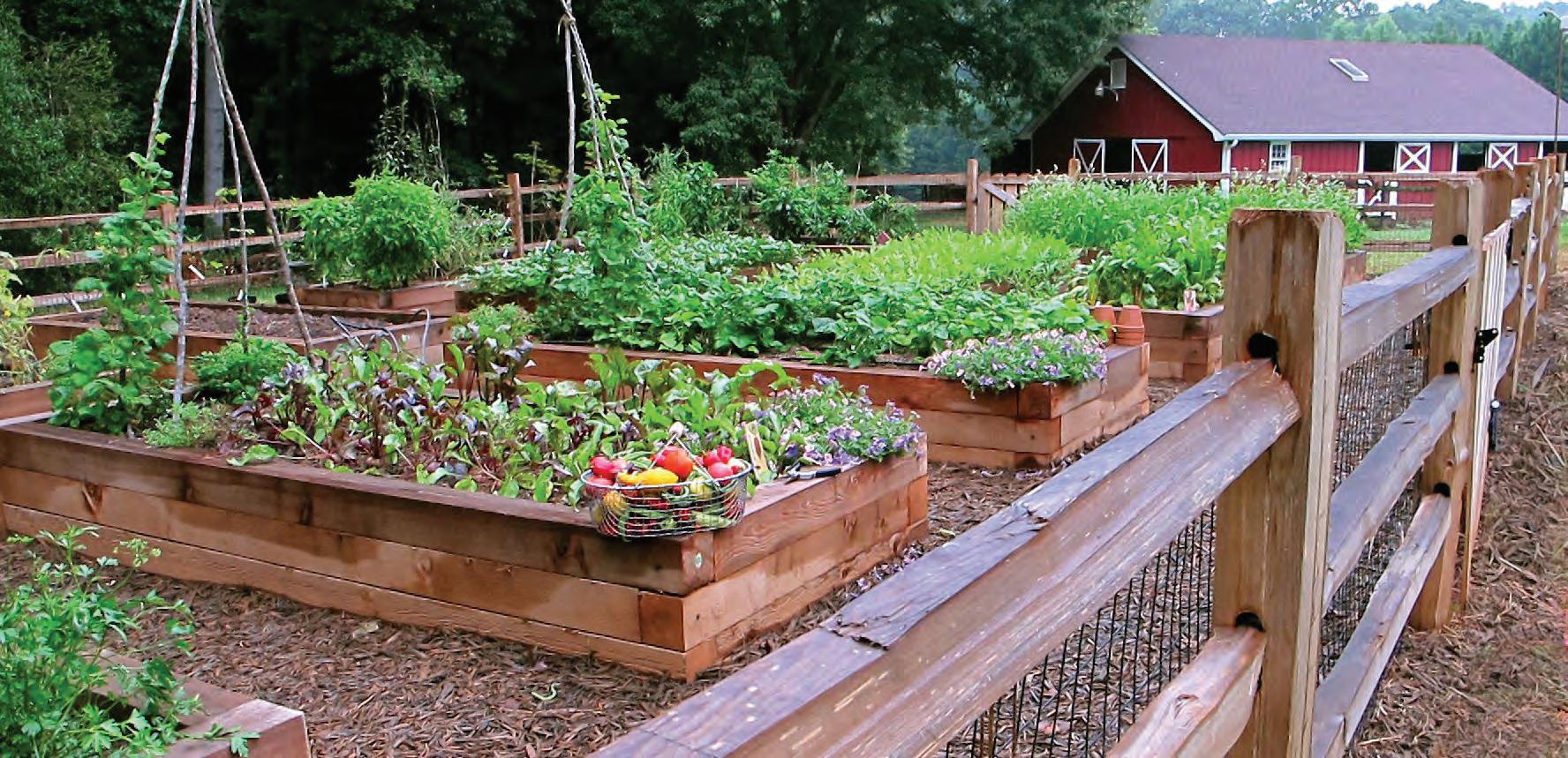
you will need the proper light set-up and the commitment to manage the process from seeds to moving the seedlings into the garden.”
Once the soil warms up, beans, squash and cucumber seeds are easy to plant directly in the garden. Their germination time is fairly quick. Be sure to purchase seeds packaged for the current year by finding the date stamp on the package and follow planting instructions.
“Vegetable plants are heavy feeders,” he says. “It’s important to fertilize them as they start to produce. A slow-release organic fertilizer is a nice way to deliver the nutrients on a continuous basis. Be sure to follow the application instructions for best results.”
Top-dressing vegetables with compost during the growing season provides additional nutrients and improves the soil.

Patio and deck Some vegetables are well-suited for planting in containers, as long as they have ample sunlight. Again, at least six hours a day applies.
Tomatoes are available in patio and bush forms that are more compact and better suited for containers. Growers have also introduced a wide variety of peppers, from sweet to hot, plus colorful bell peppers, that grow nicely on a patio.
“The key is to provide a container that’s large enough for the roots to grow and support production,” he says. “Containers also tend to dry out more often, so it’s important to keep them properly watered. Feeding regularly is important as well.”
Joe suggests avoiding clay or terra cotta pots that lose moisture more quickly.
“Lighter-colored plastic pots work better, but make sure they have drainage holes in the bottom,” he says. “Adding a layer of mulch will help retain moisture and keep the roots a little cooler. ”

Patience pays off Gardening is a lifelong learning experience and Joe says that no one gets it 100 percent right all the time.
“The number of resources — YouTube, online, websites, blogs and more — is infinite and can be overwhelming, so learn to filter the sound advice from the not-so-good,” Joe says. “Don’t get frustrated if you’re not successful in your first year of growing vegetables. Much of gardening is trial and error.”

Pamela A. Keene is a freelance journalist who writes for magazines and newspapers across the Southeast and nationally.




carolinacountry.com/extras Want to build a raised bed garden? Consider common materials to use when constructing your garden and the pros and cons of each. Watch online.
Bad to the Bone

Full tang stainless steel blade with natural bone handle —now ONLY $79!



The very best hunting knives possess a perfect balance of form and function. They’re carefully constructed from fine materials, but also have that little something extra to connect the owner with nature. If you’re on the hunt for a knife that combines impeccable craftsmanship with a sense of wonder, the $79 Huntsman Blade is the trophy you’re looking for. The blade is full tang, meaning it doesn’t stop at the handle but extends to the length of the grip for the ultimate in strength. The blade is made from 420 surgical steel, famed for its sharpness and its resistance to corrosion. The handle is made from genuine natural bone, and features decorative wood spacers and a hand-carved motif of two overlapping feathers— a reminder for you to respect and connect with the natural world. This fusion of substance and style can garner a high price tag out in the marketplace. In fact, we found full tang, stainless steel blades with bone handles in excess of $2,000. Well, that won’t cut it around here. We have mastered the hunt for the best deal, and in turn pass the spoils on to our customers. But we don’t stop there. While supplies last, we’ll include a pair of $99 8x21 power compact binoculars and a genuine leather sheath FREE when you purchase the Huntsman Blade.
Your satisfaction is 100% guaranteed.
Feel the knife in your hands, wear it on your hip, inspect the impeccable craftsmanship. If you don’t feel like we cut you a fair deal, send it back within 30 days for a complete refund of the item price. Limited Reserves. A deal like this won’t last long. We have only 1120 Huntsman Blades for this ad only. Don’t let this BONUS! Call today and beauty slip through your fingers. Call today! you’ll also receive this Huntsman Blade $249* genuine leather sheath! Offer Code Price Only $79 + S&P Save $170

EXCLUSIVE FREE
Stauer® 8x21 Compact Binoculars -a $99 value-
with purchase of Huntsman Blade
What Stauer Clients Are Saying About Our Knives
êêêêê “This knife is beautiful!”
— J., La Crescent, MN êêêêê “The feel of this knife is unbelievable...this is an incredibly fine instrument.”
— H., Arvada, CO
1-800-333-2045
Your Insider Offer Code: HUK429-01
You must use the insider offer code to get our special price.
Rating of A+
Stauer ®
14101 Southcross Drive W., Ste 155, Dept. HUK429-01 Burnsville, Minnesota 55337 www.stauer.com

Not shown actual size. *Discount is only for customers who use the offer code versus the listed original Stauer.com price.
California residents please call 1-800-333-2045 regarding Proposition 65 regulations before purchasing this product.

•12” overall length; 6 ¹⁄2” stainless steel full tang blade • Genuine bone handle with brass hand guard & bolsters • Includes genuine leather sheath
Stauer… Afford the Extraordinary. ®

2,800+ species of moths 550+ species of native bees 177 species of butterflies
1species of hummingbird Not to mention countless species of beetles, flies and wasps that also function as pollinators

Photo by reader Alyssa Rowe, a member of Haywood EMC
Support Our Pollinators
Thousands of NC insect species keep ecosystems humming, and they need your help Many types of insects transfer pollen between flower parts, or between flowers, a requirement for many plants to produce seeds and fruits. At least 75 percent of all flowering plants on earth are pollinated by insects and animals, according to the National Park Service. But pollinators need our help! Habitat loss, fragmentation, pesticide use and a changing climate are putting pollinators at risk.
Electric co-op support
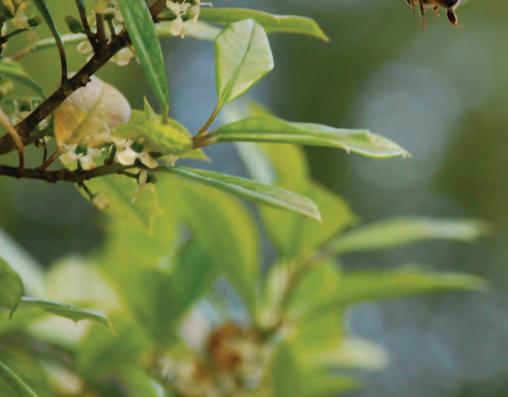
Conversations at the NC Wildlife Resources Commission about pollinator habitat decline led to the creation of the North Carolina Pollinator Conservation Alliance (ncpollinatoralliance.org) in the fall of 2017. The NC Pollinator Conservation Alliance has since grown to include more than 30 organizations representing local, state and federal government agencies, North Carolina’s Electric Cooperatives and other utility companies, non-governmental organizations, and private entities. Working together, the Alliance promotes the health and diversity of pollinators across the state through protection, management, restoration and creation of pollinator habitat.
North Carolina’s Electric Cooperatives are a part of the NC Pollinator Conservation Alliance’s energy committee, which shares ideas about creating pollinator habitat on solar farms and in utility rights-of-way.
A transmission line right-of-way near the North Carolina Electric Membership Corporation’s Hamlet power plant is a part of the state’s “Butterfly Highway.” “Pollinators are declining at alarming rates around the world. Many natural resource professionals and government agencies are focusing their efforts to enhance and create habitat for these critical species.”

— Gabriela Garrison, Eastern Piedmont habitat conservation coordinator, NC Wildlife Resources Commission
Photo by reader Corrina Carter, a member of Piedmont Electric
How you can help
On your acreage The NC Wildlife Resources Commission and the NC Pollinator Conservation Alliance have fostered partnerships with local governments, corporations and private landowners to enhance pollinator habitat on their lands. Visit ncpollinatoralliance.org or email ncpollinatoralliance@gmail.com for information on how you can improve pollinator habitat on your property. Around your home or garden Plant native species of trees, shrubs and flowers to create a “pollinator pitstop.” Visit bit.ly/nc-pollinator-plants for a list of recommended plants from the NC Wildlife Federation. You can also register your garden as an official part of the Butterfly Highway at butterflyhighway.org.
Accentuate the Positive

Reach out to friends for stress relief
By Pamela A. Keene
Since March of last year, Americans have dealt with exponential amounts of stress, depression and loneliness. Issues such as COVID-19, job loss and economic challenges have accelerated the emotional challenges that make life more complicated.
Although some of these matters are outside your control, there’s positive news.
“Few things are more important than how we feel emotionally day to day, including how we feel about ourselves,” says James E. Maddux, Ph.D., senior scholar at the Center for the Advancement of Well-Being at George Mason University in Fairfax, Virginia. “Good mental health consists not just of the absence of anxiety, loneliness, depression and stress but also of a sense of positive well-being — the sense that I am a valuable and worthwhile person and that my life has purpose and meaning.”
James says that the key is whether a person views these day-to-day challenges as a constant struggle or as something to value, look forward to and learn from.
“The way you deal with the challenges you can control and how you approach them can make all the difference,” he says. “We know from decades of research that loneliness can be detrimental to mental and physical health. For this reason, one way to improve both is to spend time on a regular basis with people we enjoy spending time with.”
Extroverts and introverts have different levels of need for companionship and alone time. “However, even the most introverted people need a few close, intimate relationships with other people,” he says. “The most extroverted and social person requires some alone time to recharge. The risk is going to the extreme in either case.”
Finding a trusted friend or family member to use as a sounding board, someone who will be candid yet sensitive to feelings, is an excellent way to deal with issues. Talking through a problem can help break the cycle of trying to figure out a solution on your own.
Exercise, just getting moving, can be another way to cope with daily stressors. “Taking a walk, meditating or doing yoga can positively influence your outlook,” James says.
Stressors can come in many forms from family pressure to work demands, dealing with health conditions — your own or those of a loved one — or simply trying to take care of everyone around you without taking care of yourself.
“One of the most important words in the English language is ‘no,’ but it’s also the hardest one to say, especially to a loved one or an important person in your life,” he says. “However, if you can learn to say ‘no’ to avoid getting overly committed, you’ve taken an invaluable first step in managing your controllable stressors.”
Pamela A. Keene is a freelance journalist who specializes in travel, gardening, personality and feature writing.

Oral Report
5 tips for keeping your mouth healthy
With many people delaying dentist office visits due to COVID-19 social distancing concerns, at-home oral care routines are more important than ever.
According to the Centers for Disease Control and Prevention, the Surgeon General’s Report on Oral Health made it clear that oral health is part of overall health and well-being. The mouth is indispensable to eating, speaking and quality of life. The most prevalent oral conditions are dental caries (cavities and tooth decay) and periodontal diseases. Fortunately, they are largely preventable with good dental hygiene.
You probably already brush your teeth, hopefully using a fluoride toothpaste. It’s also important to drink water that contains fluoride. But you can take your dental hygiene routine to an even greater level of clean with these tips from Dr. Bill Dorfman, an award-winning dentist and book author.
1Use the best tools An electric toothbrush has the power needed for optimal brushing results and has been proven to be far more effective than a manual toothbrush. Some, such as the Oral-B iO, even have advanced features, like AI recognition and micro-vibrating bristles, to help ensure you reach all areas of your mouth to provide a deeper cleaning of teeth and gums.
2Brush at least two times daily Chasing away morning breath makes it easy for most people to remember to brush in the morning, but a nighttime brushing habit is equally as important. It dislodges food debris accumulated throughout the day and reduces bacteria buildup overnight. It’s also a good idea to brush during the day if you eat or drink acidic foods and beverages, which can be harmful to enamel.
3Be thorough, yet gentle The outer surfaces of your teeth may be most visible when you flash a grin, but the inside and top surfaces need attention, too. While you focus on reaching every nook and cranny, avoid brushing too hard. Excess pressure can cause serious damage to your mouth and lead to gum recession. To ensure an all-around clean, brush for two full minutes, using an appropriate amount of pressure and methodically focusing on different areas of your mouth.
4Combat contamination Store your brush away from others so you don’t share bacteria. Prevent mold and bacteria growth by air drying between uses. Inspect the bristles for breakdown, which is a signal your brush is no longer effectively cleaning and you need a replacement head or new brush.
5Floss and rub On a daily basis, gently floss between each tooth individually and rub against each tooth at the gum line to loosen plaque and debris.
Electronics Efficiency Crossword Puzzle
It seems weird, but it’s true. Electronics use power even when they are “off.” Complete this puzzle to learn how to prevent this.
1 Down: Use a with an on/off switch when powering multiple electronics to easily manage energy use. 2 Across: For devices that require batteries, use ones, which are more cost-effective and environmentally friendly. 3 Down: Unplug electronic products, like , when you’re not using them. 4 Down: Electronics that include the Energy Star® are the most energy efficient. 5 Across: Many come with a sleep mode or power management feature, which can save $30 on annual energy costs.
2 3 1
5
WORD BANK
Ä label Ä chargers Ä computers Ä rechargeable Ä power strip
4
Delicious Discounts

Step up to the plate with affordable, flavorful dishes
Preparing a variety of meals throughout a busy week can be challenging, especially if you need to cut costs. A winning plan is to use kitchen staples on hand, along with fresh ingredients, to make delicious, affordable recipes.
Another way to spend less is to shop for groceries at discount stores. An example is Aldi, which repeatedly tests its products to ensure their quality is equal to, or better than, national leading brands. Finally, try to stock up on discounted items you regularly use.
These recipes help you make two flavorful dinners without breaking the bank.
—FamilyFeatures.com

Pressure Cooker Chicken Cacciatore
1–1½ pounds chicken breasts or chicken thighs Flour 1 pinch salt, plus 2 teaspoons, divided 2 tablespoons extra-virgin olive oil 1 onion, diced 16 ounces mushrooms, sliced 3 cloves garlic, minced ½ cup chicken broth 1 bell pepper, diced 1 can (28 ounces) diced tomatoes 4 tablespoons butter
Capers (optional)
Parsley, plus additional for topping (optional)
Lemon
Preferred pasta
Parmesan cheese (optional)
Dredge chicken in flour and pinch of salt. Turn on sauté function on pressure cooker. Add oil; sauté chicken 2–3 minutes on each side. Remove and set aside.
Add onion, mushrooms and garlic. Sauté until softened. Add broth and let sizzle out.
Add chicken, bell pepper, tomatoes and remaining salt to pressure cooker. Cook on high pressure 15 minutes. Release pressure.
Shred chicken. Stir in butter, capers, parsley and a squeeze or two of lemon juice. Serve with preferred pasta and top with additional parsley and Parmesan cheese, if desired.
Easy Chicken Enchiladas
With black beans
Nonstick cooking spray 1 medium onion, chopped Chicken 1 pound chicken breasts ¼ teaspoon garlic powder ¼ teaspoon onion powder ¼ teaspoon chili powder ¼ teaspoon cumin
Salt and pepper, to taste Enchiladas 1 can (15 ounces) black beans, drained and rinsed 1 can (10 ounces) diced tomatoes and green chilies, drained 2 cups shredded
Mexican cheese, divided 1 jar (16 ounces) restaurant-style salsa, divided 10 whole-wheat tortillas
Optional toppings
Diced avocado
Plain Greek yogurt
Cilantro
Preheat oven to 400 degrees. Coat a 9-by-13-inch pan with nonstick cooking spray and set aside. In a medium skillet over medium-high heat, cook onion until translucent, about 3–5 minutes. Transfer to large bowl and set aside.
For chicken, season chicken breasts with garlic powder, onion powder, chili powder, cumin and salt and pepper, to taste. Add chicken to same skillet over medium-high heat. Cook 5–7 minutes on each side, or until cooked through. Use fork and knife to shred chicken.
For enchiladas, in large bowl with cooked onion, add shredded chicken, black beans, diced tomatoes and green chilies and 1 cup shredded Mexican cheese. Mix well.
Pour 1 cup salsa on bottom of greased pan and use spatula to spread evenly. Scoop about ½ cup chicken and veggie mixture into each tortilla. Roll tightly and place seam side down in pan.
Top enchiladas with ¾ cup salsa and remaining shredded cheese; spread evenly.
Cover pan tightly with foil and bake 25–30 minutes. Remove from oven; serve hot. Add avocado, yogurt and cilantro, if desired.
PRAISE FOR STAUER HELENITE RINGS
êêêêê
“The clarity & color are amazing. I wear it proudly and enjoy the compliments.”

– D., St. Louis, MO
Spectacular Treasure from Mount St. Helens Only $99
A.
To show exquisite details, jewelry shown is not exact size.


American Treasure Revealed By Volcano



We transformed one of history’s most impressive displays of raw power into a romantic expression of love. Then, we gave it an epic price.
On May 18, 1980, Mount St. Helens in the Pacific Limited Reserves. Northwest erupted, sending a column of ash and smoke Don’t let this American 80,000 feet into the atmosphere. From that chaos, something treasure slip through beautiful emerged...a deep, luxurious blue stone that shines your fingers. like a Kashmir sapphire–– the most superbly blue sapphire in Call today! the world. It’s hard to believe this piece of geological history can grace her finger for under $99. But you can believe it. The stone in the Blue Fire Helenite Ring is created from heating the ancient minerals contained in the volcanic ash unearthed by the historical eruption of Mount St. Helens. Featuring five full carats in a stunning emerald cut, the stone flashes and flickers in radiant glory, echoing its dramatic origins. Set in sterling silver and accented with sparkling white stones, this ring is perfect for letting her know she’s your greatest treasure. Satisfaction guaranteed or your money back. Experience A. the deep blue beauty of the Blue Fire Helenite Ring for 30 days. If she isn’t completely blown away, send it back for a full refund of the item price. At Stauer, romance is guaranteed.

— Harper’s BAZAAR, 2018
C. B.
Blue Fire Helenite Collection
A. Ring (6 1/3 ctw) $499† $99 Save $400 B. Pendant (8 ctw) $499† $99 Save $400 18” sterling silver chain $59 C. Earrings (10 ctw) $699† $199 Save $500
BEST DEAL - Pendant, Chain & Earrings
$1,257 $249 Save $1,008
You must use the insider offer code to get our special price.
1-800-333-2045
Your Insider Offer Code: BFR133-01
Please use this code when you order to receive your special discount.
† Special price only for customers using the offer code versus the price on Stauer.com without your offer code. Stauer ®
Rating of A+ 14101 Southcross Drive W., Ste 155, Dept. BFR133-01, Burnsville, Minnesota 55337 www.stauer.com
• Blue helenite; The Ultimate Diamond Alternative®, DiamondAura® accent stones • Rhodium-finished .925 sterling silver setting • Whole ring sizes 5-10
Stauer… Afford the Extraordinary. ®
Put Up Your Harvest
Safe canning and food preservation techniques for your kitchen
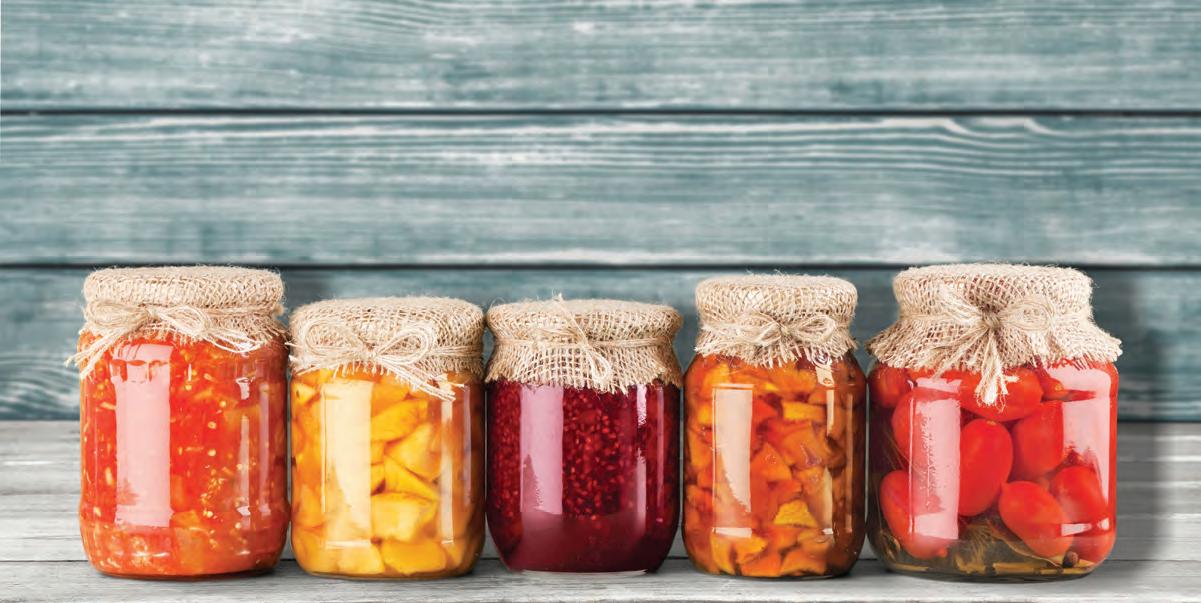
By Pamela A. Keene
There’s nothing better than using home-canned tomatoes in an Italian recipe, or pulling out a quart of fresh-frozen peaches to make a bubbly cobbler. However, if the only thing you know about food preservation is your grandmother’s jam-making on a hot summer afternoon, you’ve got a whole lot of catching up to do.
“People have been preserving food for centuries, but as we learn more about foodborne illness and spoilage — and changes in our food supply and developments in canning equipment take place — recommendations are updated frequently to provide reliable ways to safely reap the bounty of our garden’s harvest,” explains Elizabeth Andress, Ph.D., director of the National Center for Home Food Preservation and food safety specialist with the Georgia Cooperative Extension. “Food preservation knowledge and techniques need to be based on sound food science for safety; we’re still targeting the same bacteria in canning as we have for a long, long time.”
From the garden to the table, food handling and kitchen hygiene standards are crucial to successful food preservation. Because ongoing research reflects updated methods, Elizabeth strongly suggests consumers use the most recent information available.
Canning
Preserving food by canning presents several options: pressure canning, water-bath canning and steam canning. Different equipment is required for each.
“Each has its benefits and drawbacks, but in any case, it’s important to follow the instructions exactly and familiarize yourself with each before attempting to can at home,” Elizabeth says. “An important consideration for choosing the proper canning technique depends on the acidity of the food you’re canning. For instance, higher- acid foods (like fruits) can be processed in a water-bath canner. But foods with a lower acid content (like meats and soups) must be preserved using a pressure canner.”
Some foods, such as tomatoes, can be preserved using a water-bath, but it’s important to add citric acid or lemon juice to acidify them. Pickles, because of the added vinegar, can also be canned using a water-bath if a tested recipe is followed.
“For a beginner, we suggest canning peaches or making applesauce to become comfortable with the equipment and the process,” Elizabeth says. “Both use the water-bath method, which involves placing filled containers into a large pot of boiling water that covers the whole jar and lid and boiling them for the exact time shown in the recipe. Whenever canning, we recommend using a tested recipe from a reliable source, such as the National Center for Food Preservation.”
Yellow peaches can be peeled, cut into halves or slices, packed into jars, then covered with water or sugar syrup before putting on the lids and placing into the boiling water.
“Choose between raw pack or hot pack when you fill the jars,” she says. “With the raw pack, put the freshly peeled and sliced peaches into a clean hot jar, then cover with hot syrup. Hot-pack canning means that you cook the peaches in syrup first, then fill the jars with the hot fruit and liquid before processing.”
Applesauce can be processed using a water bath as well. Use the hot-pack method for filling the jars.
“When putting on the lids, be sure to wipe the jars’ sealing edges with a clean, damp cloth to remove bits of food that may prevent the jars from sealing properly,” Elizabeth says.
Freezing
Certain foods freeze better than others. “Many vegetables are not suited for freezing, such as cucumbers, radishes, raw potatoes or onions,” Elizabeth says. “On the other hand, vegetables like green beans and asparagus, and fruits like blueberries or peaches are easy to freeze.”
Green beans, corn, carrots and broccoli need to be blanched — submerged in boiling water for the prescribed time on the recipe — before freezing. Then they can be transferred to an ice bath for rapid cooling, drained and packed into containers.
“Once they’re blanched and drained, place them in a single layer on a cookie sheet and freeze them individually,” Elizabeth says. “Then pack into freezer-safe containers, label and store.”
Fruits such as blueberries, cherries, grapes, fresh-sliced peaches and strawberries can simply be placed on cookie sheets and allowed to freeze individually before packing. Remove as much air as possible before sealing.
“Fruits can be frozen with or without added sugar or liquid, depending on what you plan to use them for,” she says. “Freezing can be an easy way to preserve food. However, the same safe-handling guidelines apply. Keep your work surfaces clean, wash your hands often and carefully label the packages with the date processed and the contents.”
Herbs can be frozen as well.
“If you grow basil or oregano in the summer, just chop the fresh leaves and put them into ice-cube trays covered with water,” she says. “Once they’re frozen, package them in a freezer-safe container, then when you need some herbs for a soup or sauce recipe, take out the frozen cube and add it to the sauce. You can also do this for smaller quantities of hot peppers or onions.”

Back to kitchen basics
Canning and freezing have long been used to preserve food. Today’s conveniences have made it easier to enjoy the rewards of growing your own food long after the harvest is over.
“Because of the pandemic, more and more people are turning to home food growing and preservation,” she says. “Just be certain to follow all the guidelines and recipes exactly. Don’t take any shortcuts or change ingredients or timing. The recipes we provide through the National Center for Preservation have been extensively tested. The key is to be meticulous, whether you’re canning or freezing. That way you can be assured of the freshest flavors and the safest results.”

Pamela A. Keene is a freelance journalist who writes for magazines and newspapers across the Southeast and nationally.
carolinacountry.com/extras Inspired to try canning? Gather some tart plums, sugar and lemon juice to make this easy Plum Jam recipe using the water-bath method. Elizabeth Andress, food safety specialist

Elizabeth measures jar head space.
A safe canning resource
From explaining the science of canning to providing how-to recipes, the “Complete Guide to Home Canning” from the U.S. Department of Agriculture is a safe, comprehensive guide to preserving food at home: bit.ly/canningfood



